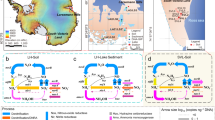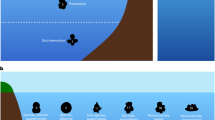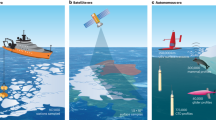Abstract
Marine sediments contain about 500–10,000 Gt of methane carbon1,2,3, primarily in gas hydrate. This reservoir is comparable in size to the amount of organic carbon in land biota, terrestrial soils, the atmosphere and sea water combined1,4, but it releases relatively little methane to the ocean and atmosphere5. Sedimentary microbes convert most of the dissolved methane to carbon dioxide6,7. Here we show that a significant additional product associated with microbial methane consumption is methane-derived dissolved organic carbon. We use Δ14C and δ13C measurements and isotopic mass-balance calculations to evaluate the contribution of methane-derived carbon to seawater dissolved organic carbon overlying gas hydrate-bearing seeps in the northeastern Pacific Ocean. We show that carbon derived from fossil methane accounts for up to 28% of the dissolved organic carbon. This methane-derived material is much older, and more depleted in 13C, than background dissolved organic carbon. We suggest that fossil methane-derived carbon may contribute significantly to the estimated 4,000–6,000 year age of dissolved organic carbon in the deep ocean8, and provide reduced organic matter and energy to deep-ocean microbial communities.
This is a preview of subscription content, access via your institution
Access options
Subscribe to this journal
Receive 12 print issues and online access
$259.00 per year
only $21.58 per issue
Buy this article
- Purchase on Springer Link
- Instant access to full article PDF
Prices may be subject to local taxes which are calculated during checkout



Similar content being viewed by others
References
Kvenvolden, K. A. Methane hydrate—a major reservoir of carbon in the shallow geosphere? Chem. Geol. 71, 41–51 (1988).
Milkov, A. V. Global estimates of hydrate-bound gas in marine sediments: How much is really out there? Earth Sci. Rev. 66, 183–197 (2004).
Buffet, B. & Archer, D. Global inventory of methane clathrate: Sensitivity to changes in the deep ocean. Earth Planet. Sci. Lett. 227, 185–199 (2004).
Hedges, J. I. Global biogeochemical cycles: Progress and problems. Mar. Chem. 39, 67–93 (1992).
Reeburgh, W. S. Oceanic methane biogeochemistry. Chem. Rev. 107, 486–513 (2007).
Hinrichs, K-U. & Boetius, A. in Ocean Margin Systems (eds Wefer, G. et al.) (Springer, 2002).
Hoehler, T. M., Alperin, M. J., Albert, D. B. & Martens, C. S. Field and laboratory studies of methane oxidation in an anoxic marine sediment—evidence for a methanogen–sulfate reducer consortium. Glob. Biogeochem. Cycles 8, 451–463 (1994).
Williams, P. M. & Druffel, E. R. M. Dissolved organic matter in the ocean: Comments on a controversy. Oceanography 1, 14–17 (1988).
Bauer, J. E. & Druffel, E. R. M. Ocean margins as a significant source of organic matter to the deep ocean. Nature 392, 482–485 (1998).
Dittmar, T. & Koch, B. P. Thermogenic organic matter dissolved in the abyssal ocean. Mar. Chem. 102, 208–217 (2006).
Wang, X-C., Chen, R. F., Whelan, J. & Eglinton, L. Contribution of ‘old’ carbon from natural marine hydrocarbon seeps to sedimentary and dissolved organic carbon pools in the Gulf of Mexico. Geophys. Res. Lett. 28, 3313–3316 (2001).
Bauer, J. E., Druffel, E. R. M., Wolgast, D. M., Griffin, S. & Masiello, C. A. Distributions of dissolved organic and inorganic carbon and radiocarbon in the eastern North Pacific continental margin. Deep-Sea Res. II 45, 689–713 (1998).
Pohlman, J. W. Sediment Biogeochemistry of Northern Cascadia Margin Shallow Gas Hydrate Systems (College of William and Mary, 2006).
Pohlman, J. W. et al. The origin of thermogenic gas hydrates on the northern Cascadia Margin as inferred from isotopic (13C/12C and D/H) and molecular composition of hydrate and vent gas. Org. Geochem. 36, 703–716 (2005).
Pohlman, J. W. et al. Methane sources in gas hydrate bearing cold seeps: Evidence from radiocarbon and stable isotopes. Mar. Chem. 115, 102–109 (2009).
Alperin, M. J., Reeburgh, W. S. & Whiticar, M. J. Carbon and hydrogen isotope fractionation resulting from anaerobic methane oxidation. Glob. Biogeochem. Cycles 2, 279–288 (1988).
Valentine, D. L. et al. Biogeochemical investigations of marine methane seeps, Hydrate Ridge, Oregon. J. Geophys. Res. 110, G02005 (2005).
Segers, R. Methane production and consumption: A review of processes underlying wetland methane fluxes. Biogeochemistry 41, 23–51 (1998).
Miller, J. B. & Tans, P. P. Calculating isotopic fractionation from atmospheric measurements at various scales. Tellus 55, 207–214 (2003).
Heuer, V. B., Pohlman, J. W., Torres, M. E., Elvert, M. & Hinrichs, K-U. The stable carbon isotope biogeochemistry of acetate and other dissolved carbon species in deep subseafloor sediments of the northern Cascadia Margin. Geochim. Cosmochim. Acta 73, 3323–3336 (2009).
Mau, S. et al. Estimates of methane output from mud extrusions at the erosive convergent margin off Costa Rica. Mar. Geol. 225, 129–144 (2007).
Sauter, E. J. et al. Methane discharge from a deep-sea submarine volcano into the upper water column by gas hydrate-coated methane bubbles. Earth Planet. Sci. Lett. 243, 354–365 (2004).
Milkov, A. V. Worldwide distribution of submarine mud volcanoes and associated gas hydrates. Mar. Geol. 167, 29–42 (2000).
Kvenvolden, K. A., Lorenson, T. D. & Reeburgh, W. S. Attention turns to naturally occurring methane seepage. Eos 82, 457 (2001).
Frye, M. Preliminary Evaluation of in-Place Gas Hydrate Resources: Gulf of Mexico Outer Continental Shelf. MMS Report 2008–004 (US Department of Interior, Minerals Management Service, 2008).
Zachos, J. C. et al. Rapid acidification of the ocean during the Paleocene–Eocene thermal maximum. Science 308, 1611–1615 (2005).
Pohlman, J. W., Ruppel, C., Hutchinson, D. R. & Coffin, R. B. Assessing sulfate reduction and methane cycling in a high salinity pore water system in the northern Gulf of Mexico. Mar. Petrol. Geol. 25, 942–951 (2008).
Stuiver, M. & Polach, H. A. Discussion: Reporting of 14C data. Radiocarbon 19, 355–363 (1977).
Osburn, C. L. & St-Jean, G. The use of wet chemical oxidation with high-amplification isotope ratio mass spectrometry (WCO-IRMS) to measure stable isotope values of dissolved organic carbon in seawater. Limnol. Oceanogr. Methods 5, 296–308 (2007).
Ricker, W. E. Linear regressions in fishery research. J. Fish. Res. Board Can. 30, 409–434 (1973).
Acknowledgements
We thank the captain and crew of the CCGV J. P. Tully and ROV ROPOS, E. Kessee, B. Green and L. Lapham for assistance with sample collection and analysis, and the staffs of the University of Arizona and National Ocean Science AMS facilities for radiocarbon analyses. J. Seewald, V.B. Heuer and D.L. Valentine are thanked for constructive comments on previous versions of the manuscript. This research was supported by financial support from the Natural Sciences and Engineering Research Council (NSERC) of Canada, the Chemical Oceanography and Integrated Carbon Cycle Research Programs of the National Science Foundation and the USGS Mendenhall Research Postdoctoral Fellowship Program. Any use of trade names is only for descriptive purposes and does not imply endorsement by the US Government.
Author information
Authors and Affiliations
Contributions
J.W.P. led and coordinated the design and execution of the field study, collection and analyses of samples, and writing of the manuscript. J.E.B. and W.F.W. contributed to the study design, sample analyses, development of the mass-balance model and writing of the manuscript. All other authors made essential, substantive contributions to the original and revised versions of the manuscript. In addition, C.L.O. assisted with pore-water DOC δ13C analyses and N.R.C. was Chief Scientist and contributed to the study design and sampling at sea.
Corresponding author
Ethics declarations
Competing interests
The authors declare no competing financial interests.
Supplementary information
Supplementary Information
Supplementary Information (PDF 943 kb)
Rights and permissions
About this article
Cite this article
Pohlman, J., Bauer, J., Waite, W. et al. Methane hydrate-bearing seeps as a source of aged dissolved organic carbon to the oceans. Nature Geosci 4, 37–41 (2011). https://doi.org/10.1038/ngeo1016
Received:
Accepted:
Published:
Issue Date:
DOI: https://doi.org/10.1038/ngeo1016
This article is cited by
-
The black carbon cycle and its role in the Earth system
Nature Reviews Earth & Environment (2022)
-
Submarine mud volcanoes as a source of chromophoric dissolved organic matter to the deep waters of the Gulf of Cádiz
Scientific Reports (2021)
-
Seismic loading of fault-controlled fluid seepage systems by great subduction earthquakes
Scientific Reports (2019)
-
Microbial decomposition of marine dissolved organic matter in cool oceanic crust
Nature Geoscience (2018)
-
Methane- and dissolved organic carbon-fueled microbial loop supports a tropical subterranean estuary ecosystem
Nature Communications (2017)



